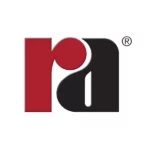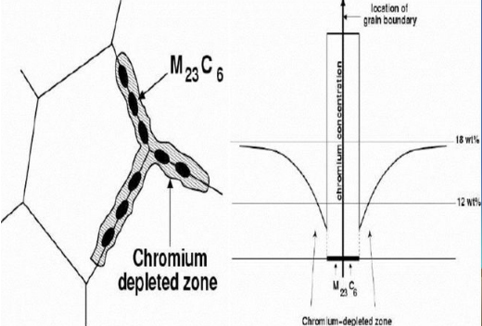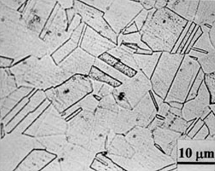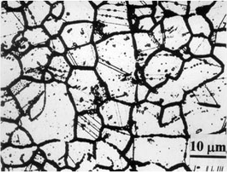Share:
Sensitization is a phenomenon that can occur in stainless steel and even some nickel alloys. It is a critical concept that needs to be understood as it can adversely affect the performance of stainless steel and nickel alloys.
Sensitization is the precipitation of carbides at grain boundaries that leaves adjacent regions depleted in chromium and susceptible to intergranular corrosion. Sensitization occurs when a material is exposed to a specific range of temperatures for a time sufficient for carbides to form. In the case of austenitic stainless steels, they can commonly become sensitized between 900°F – 1500°F. Sensitization can occur either through operating in this range or slowly cooling through this range. The figure below shows what happens when a material becomes sensitized. Chromium within the grain will navigate to the grain boundary to form carbides, leaving behind a chromium-depleted region adjacent to the carbides.
For stainless steel and nickel alloys to retain a protective chromium oxide layer, the material must have a uniform chromium composition of at least 12%. When sensitization occurs, the chromium-depleted areas will contain less than 12% chromium, leaving the material susceptible to intergranular corrosion. In the most severe cases, intergranular corrosion advances to the point where individual surface grains can physically separate and drop out of the surface of the material. The photographs below show a non-sensitized microstructure on the left and a sensitized microstructure on the right.
Multiple methods have been used across industry to control or minimize the likelihood of sensitization occurring. A few of these methods are discussed below:
– High-temperature solution annealing is performed by heating material to a temperature between 1950°F – 2050°F and immediately quenching. At the process temperature, all grain boundary carbides dissolve into solution. Quenching should be rapid enough to ensure that the carbon stays in solution.
– The addition of strong carbide formers or stabilizing elements such as niobium or titanium results in carbides forming with these elements instead of chromium because they have a greater affinity for carbon. The contents of these alloying elements are calculated so that all carbon is tied up by these elements instead of chromium. Examples of stabilized grades include 321 and 347.
– Another option is to utilize low-carbon stainless steel. Many stainless grades have a low-carbon version, such as 304L and 316L, that restricts carbon to a 0.03% maximum. Restricting carbon to such a low limit minimizes the quantity of carbon available for the precipitation of grain boundary carbides. Low-carbon grades are preferred to avoid sensitization. However, a lower carbon content results in a lower-strength material. Through adjustments, many of the 300 series austenitic stainless steels are dual-certified to meet the low carbon limit and higher strength requirements. In addition to meeting the strength and chemistry requirements, it is common to see an intergranular corrosion test on a material test report, such as ASTM A262 Practice E. This corrosion test starts with a sample that has seen temperatures within the sensitization range and is then submitted for corrosion testing. This ensures that if the material sees elevated temperature during service or welding, it shouldn’t become sensitized.
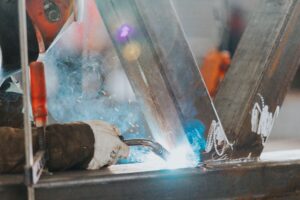
Welding Consumable Designations and Selection Criteria
Understanding welding consumable designations is essential for achieving strong, reliable welds. This guide breaks down AWS standards, electrode naming conventions, and key factors like polarity, base materials, and welding position to help you choose the right filler metal every time.
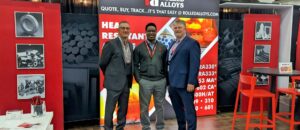
2025 Trade Shows
Come talk to a Rolled Alloys representative in person about your project. You can find us at these trade shows.

March Mania 2025
Every Online Order in March is a Chance to Win One of 8 Great Prizes!
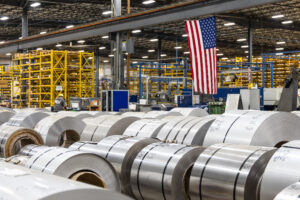
Instant Pricing on Nickel, Stainless Steel, Duplex, and Titanium
Get real-time pricing and availability for nickel, stainless steel, duplex, and titanium—all in one place.
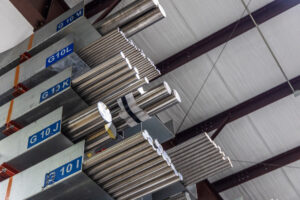
New and Expanded Stock for 2025
New Titanium, Stainless, Nickel and Cobalt in Stock Now – CP Ti Grade 2, 635, 718 and More!
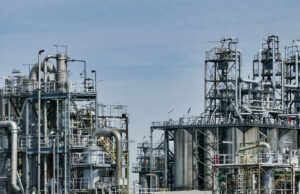
History and Uses of Alloy 800
Discover the evolution of Alloy 800, from its origins during the 1950s to modern derivatives like Alloy 800H/800HT. Learn about its high-temperature strength, petrochemical applications, and commercial availability today.

